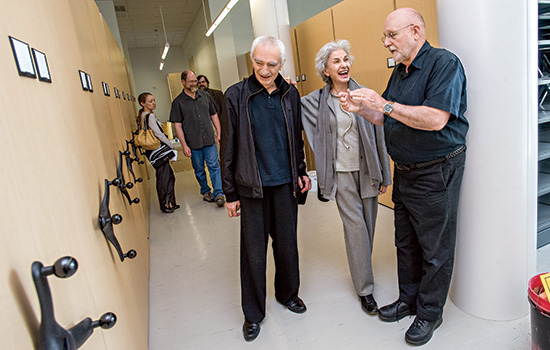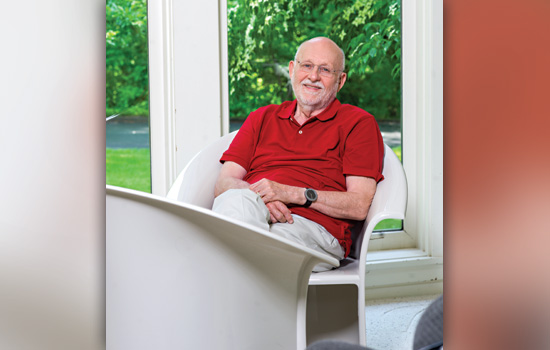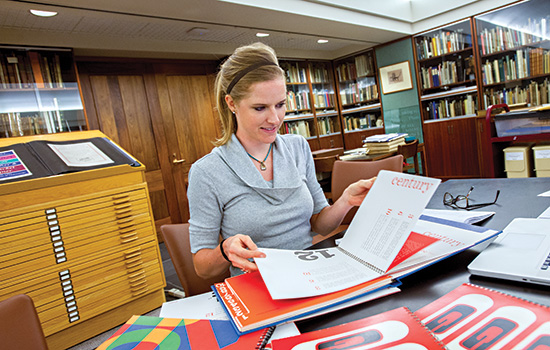50 years and counting for Roger Remington
Longest-serving faculty member Roger Remington still has more to accomplish
A. Sue Weisler
Casey Kelly ’13 looks at corporate identity manuals in the Graphic Design Archive.
Casey Kelly ’13 (graphic design) graduated with a better handle on her own design methods because she spent the last two years digging through the archives of American design pioneers.
“You can experience firsthand design from the past,” Kelly says. “It’s a different experience to flip through boxes and see the designs for yourself.”
RIT has R. Roger Remington to thank for that. Remington not only built a nationally recognized design department, but he made RIT an international resource for design history. The combination attracts top-notch students such as Kelly, who landed a job after graduation working for White Bicycle, a design studio in her hometown of Buffalo.
Remington will celebrate 50 years of teaching at RIT this fall. He is the longest- serving faculty member at the university.
The Graphic Design Archive he created now includes the work of 40 designers and continues to grow. In addition, RIT is home to the Vignelli Center for Design Studies, which houses the archive of renowned designers Massimo and Lella Vignelli.
“There’s no other university that has anything comparable to what Roger has done with the center and the archives. I don’t think even people at RIT realize what he has done,” says Massimo Vignelli. “The only comparison I can make is Einstein at Princeton. Princeton is famous because of Einstein and RIT is famous because of Roger Remington.”
Early years
Remington, who grew up in Glens Falls, N.Y., was introduced to RIT in the 1950s when he was an art and design student. The head of the School of Art and Design at the time, Stanley Witmeyer, was transitioning the program from a traditional Beaux Arts academy to a modern design program. As a result, Remington says, he graduated in 1958 with experience in both styles.
He applied to several graduate schools and was attracted to the University of Wisconsin-Madison, where he studied printmaking and took advantage of the school’s strong art history program.
“I just soaked that up like crazy,” Remington says.
After graduating, he returned to New York state and worked in packaging design for three years before he decided he wanted to teach. Montana State University in Bozeman needed a design teacher and Remington took the job—sight unseen. He became the only graphic designer in the school’s small art department until 1963.
“One Saturday morning I got a call from Stan Witmeyer,” Remington says. “He said, ‘Would you like to come back to RIT to teach? We are building a new campus, and we would like to have you be part of our faculty.’”
Remington says those early years at RIT were challenging. The transition from an intimate downtown setting to the sprawling Henrietta campus was stressful.
But it also was exciting. Remington had the opportunity to work on the branding program for the new school, which was used by RIT for two decades. He helped build a graphic design department, which he chaired for seven years. And he started to make an impact on students.
“Roger was a unique combination of mentor, teacher and designer,” says Lee Green ’74 (art and design). “This is someone who has extremely high standards and is very passionate about what he does.”
Remington transferred those high standards to his students, says Green, now vice president for brand experience and strategic design at IBM. “He was constantly encouraging you to push and do more and improve.”
That push was evident in the late 1970s when Remington realized that his students knew little about the history of design. He integrated history into his studio classes, and a few years later, he developed and taught electives in the history of design.
The students embraced that focus, and in 1978, Remington was presented with the Eisenhart Award for Outstanding Teaching, RIT’s highest recognition for faculty members.
Eager to gain more momentum on history, theory and criticism, Remington mounted a national conference in 1983 with colleague Barbara Hodik, which brought generations of designers to RIT. Vignelli was the keynote speaker.
“That put us on the map,” Remington says. “That gave me a strong position in which to pursue other activities.”
Telling stories
One of those activities was writing an article for Communication Arts about American graphic design pioneer Lester Beall, who is best known for his posters for the U.S. government’s Rural Electrification Administration in the late 1930s.
When researching the article, Remington contacted Beall’s family and drove to Connecticut to meet Beall’s widow and daughter. Soon after he finished the article, he got a call from Beall’s daughter.
“She said, ‘My mother has to go into a nursing home and we have to get rid of his archive. Would you like it at your school?’ ”
Even though he had no budget and no place to put it, Remington rented a truck, drove to Connecticut and picked up boxes of personal papers, business documents and original artwork.
Other donations followed as Remington made contacts in the design world. Today, 40 graphic designers from the American Modernist generation are represented in the collection, which is part of the Cary Graphic Arts Collection in The Wallace Center. The Beall collection is one of the largest.
“Researchers from all over the world travel to Rochester to examine the collections,” says Kari Horowicz, librarian for the College of Imaging Arts and Sciences. “In addition, the collections are frequently sought for exhibitions in museums both nationally and internationally.”
Students benefit the most. They can hold sketchbooks, see original photographs and architectural models and examine printed samples to get a better understanding of how a design was created.
Bruce Ian Meader, associate professor of design, says Remington uses the Graphic Design Archive to tell stories about the designers as people and what the world was like when they were working.
“He makes history come alive for students,” says Meader, who has become close friends with Remington. “In many cases he knew a lot of the pioneers of graphic design when they were still alive or knew people from their family and found out a lot about who they were as human beings.”
Vignelli Center
When Vignelli decided it was time to downsize his business in New York City, he says, there was only one place in the world where he wanted his archive housed. The problem was that the collection was too big to fit with the others at The Wallace Center.
After five years of planning and substantial institutional support, the Vignelli Center for Design Studies opened on campus in 2010 in a building designed by Vignelli. Inside, students have access to original source materials and examples of the couple’s finished work, which includes corporate identity campaigns for Xerox, American Airlines and Bloomingdale’s; street signage; jewelry; glassware; and furniture.
Vignelli says the project would never have been built without Remington, whom he calls the soul of the center. “It is really the Roger Remington Center nicknamed the Vignelli Center.”
Josh Owen, associate professor and chair of the industrial design program, says the center is a landmark gift to the world. Owen says the center’s archive is a valuable tool for his industrial design students. “The center is like an eternal flame for design education—Roger has provided the fuel.”
Remington, who in 2006 became the first faculty member in the School of Design to receive an endowed professorship (the Lella and Massimo Vignelli Distinguished Professor of Design), says his goal for the coming years is to make the center even more valuable. He will do that by expanding programming activities, which includes workshops and lecture series.
He and his colleagues also are working on a proposal to start an MS degree in design studies. The two-year program would include a summer studying abroad and would focus on the history, theory and criticism of design. Studying abroad is important to Remington, who has worked as a guest professor at two schools in Germany.
Remington plans to be in the classroom this fall teaching undergraduates about the history of the magazine. He has published four books on design history and has others in the pipeline.
Earlier this year, he was asked to join Alliance Graphique Internationale, an elite society of graphic design professionals worldwide. His official induction will be in London in September—shortly after he celebrates 50 years at RIT on Sept. 1.
“Sometimes the fit of faculty members into a department or program is not very good so they leave and try to find the right niche,” Remington says. “For me, working at RIT has always been a situation where I have been able to find open doors to what I wanted to do.”
 Massimo and Lella Vignelli talk with R. Roger Remington inside the Vignelli Center for Design Studies in 2010.
A. Sue Weisler
Massimo and Lella Vignelli talk with R. Roger Remington inside the Vignelli Center for Design Studies in 2010.
A. Sue Weisler
 The Vignelli Center for Design Studies opened in 2010 in a building designed by Massimo Vignelli.
A. Sue Weisler
The Vignelli Center for Design Studies opened in 2010 in a building designed by Massimo Vignelli.
A. Sue Weisler
 Remington, the Lella and Massimo Vignelli Distinguished Professor of Design, will celebrate 50 years of teaching at RIT this fall.
A. Sue Weisler
Remington, the Lella and Massimo Vignelli Distinguished Professor of Design, will celebrate 50 years of teaching at RIT this fall.
A. Sue Weisler














